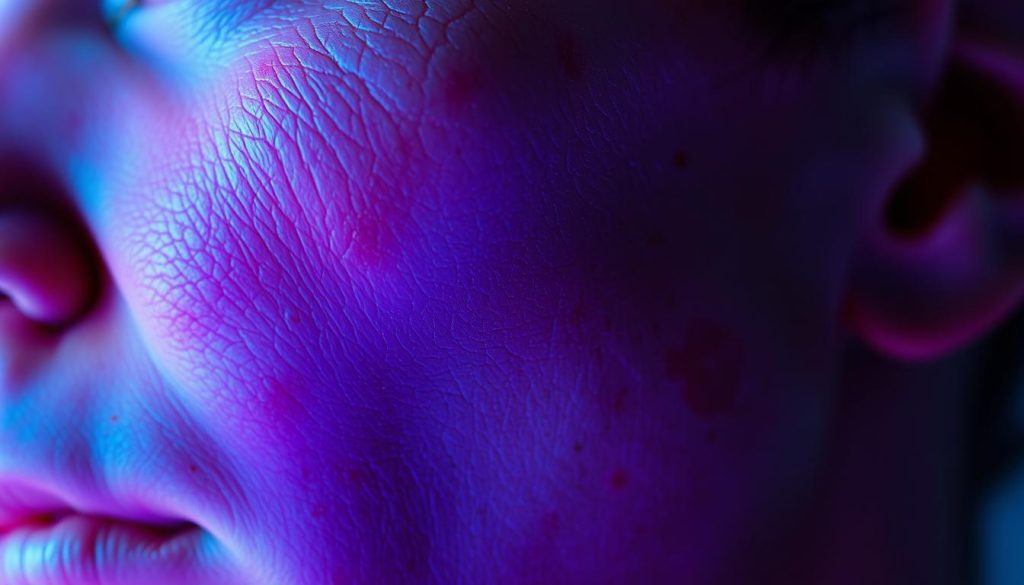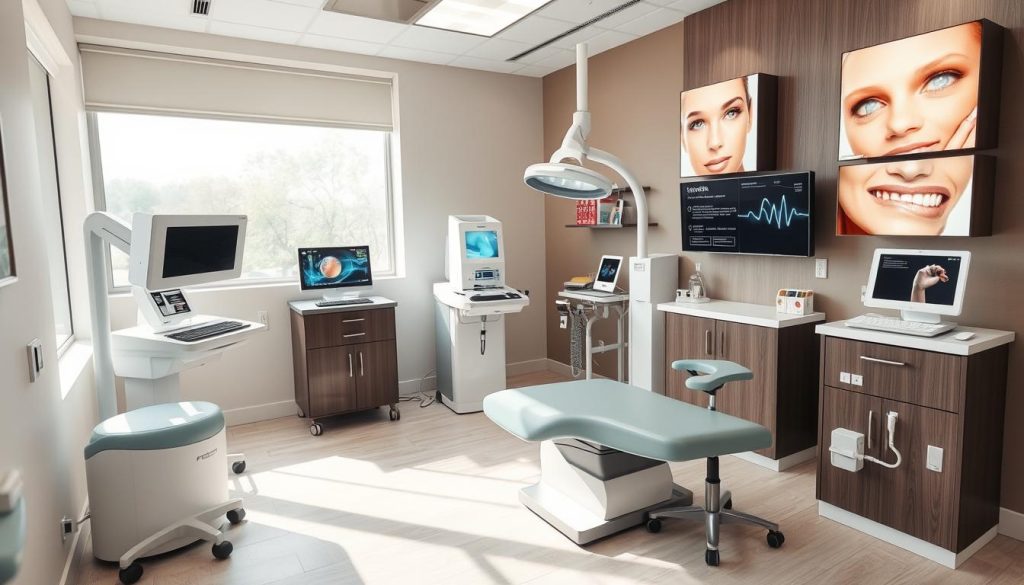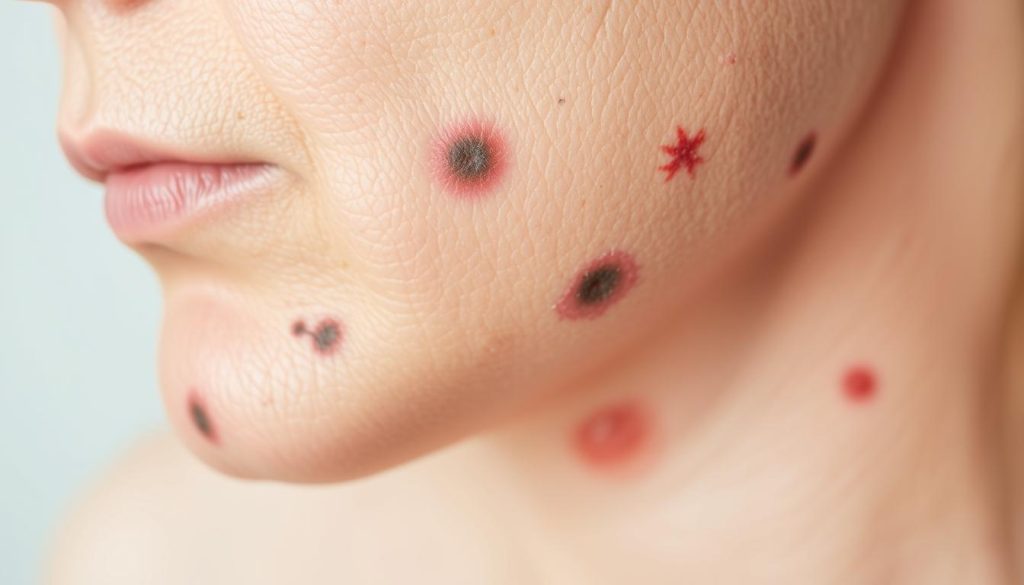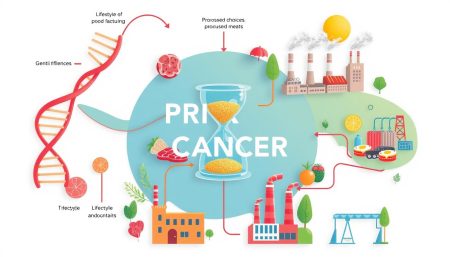Skin cancer is a serious health issue affecting millions in the U.S. each year. Early detection is key to successful treatment and better survival rates. Knowing the warning signs of skin cancer, including melanoma, can save lives.
Understanding the different types of skin cancer and their symptoms is important. It helps you take care of your skin health. By spotting early signs, you can get medical help quickly and prevent the disease from getting worse.
In this guide, we’ll cover the main warning signs of skin cancer, risk factors, and how to prevent it. With this knowledge, you can protect yourself and your loved ones from skin cancer.
Understanding Different Types of Skin Cancer
Skin cancer has many forms, each with its own traits. Knowing these types is key to catching it early and treating it right. Let’s look at the three main ones: basal cell carcinoma, squamous cell carcinoma, and melanoma.
Basal Cell Carcinoma: Most Common Form
Basal cell carcinoma is the most common skin cancer. It shows up as a pearly bump or a flat, flesh-colored spot. This type doesn’t usually spread but can grow deep, harming nearby tissues.
Squamous Cell Carcinoma: Signs and Risks
Squamous cell carcinoma looks like a red, scaly patch or a firm bump. It’s more likely to spread than basal cell carcinoma. People with fair skin or who spend a lot of time in the sun are at higher risk.
Melanoma: Most Dangerous Type
Melanoma is the most serious skin cancer. It looks like moles and can grow in existing ones. Catching it early is vital because melanoma can spread fast to other parts of the body.
| Skin Cancer Type | Appearance | Risk Level |
|---|---|---|
| Basal Cell Carcinoma | Pearly bump or flat lesion | Low |
| Squamous Cell Carcinoma | Red, scaly patch or firm bump | Moderate |
| Melanoma | Irregular mole-like growth | High |
Knowing about these skin cancer types helps spot problems early. Regular skin checks and quick action for any growths are important for managing skin cancer risks.
Skin Cancer and Common Risk Factors
Knowing what increases your risk of skin cancer is key to staying safe. UV radiation from the sun is a big problem. People who spend a lot of time outside without protection are at risk. This includes those who work outside or love going to the beach.
Having fair skin also raises your risk. People with light skin have less melanin, which protects against UV damage. Redheads and blondes are extra careful. But, anyone can get skin cancer, no matter their skin tone.

Family history matters too. If your family has had skin cancer, you’re more likely to get it. This shows why regular checks are important, even more so if you have a family history.
| Risk Factor | Impact Level | Prevention Strategy |
|---|---|---|
| UV radiation | High | Use sunscreen, seek shade |
| Fair skin | Moderate to High | Extra sun protection, regular skin checks |
| Family history | Moderate | Early and frequent screenings |
| Frequent sunburns | High | Avoid tanning, use protective clothing |
Other things that raise your risk include sunburns, tanning beds, and some health conditions or meds. By knowing these risks, you can protect yourself and keep your skin healthy.
Critical Early Warning Signs of Skin Cancer
Spotting skin cancer early is key to effective treatment. This part talks about important warning signs and how to check your skin for them.
The ABCDE Rule of Melanoma Detection
The ABCDE rule helps find melanoma, the most serious skin cancer type. It’s a simple guide to spot odd moles:
| Letter | Stands For | Description |
|---|---|---|
| A | Asymmetry | One half doesn’t match the other |
| B | Border | Irregular, jagged, or scalloped edges |
| C | Color | Multiple colors or uneven distribution |
| D | Diameter | Larger than 6mm (pencil eraser size) |
| E | Evolving | Changes in size, shape, or color over time |
Changes in Existing Moles
Keep an eye on your moles, as changes can mean skin cancer. Look for:
- Growth or shrinkage
- Changes in texture or sensation
- Bleeding or itching
New Growth Patterns to Monitor
New skin spots might be early signs of skin cancer. Watch for:
- Dome-shaped growths
- Sores that don’t heal
- Flat, scaly patches with raised edges
Regular self-exams and doctor visits are important for catching skin cancer early. If you see anything odd, see a dermatologist right away.
How UV Radiation Affects Your Skin

UV radiation is harmful to your skin. When sunlight hits your skin, it goes deep, causing damage. The first sign is sunburn, which happens when UV rays hurt the skin’s top layer.
Long-term UV exposure causes skin to age early. This is called photoaging. It leads to wrinkles, age spots, and a tough skin texture. The damage to collagen and elastin fibers is why you see these signs of aging.
The biggest worry is DNA damage in skin cells. This can lead to mutations and skin cancer. The body tries to fix this damage, but it’s hard, mainly with too much sun.
- Sunburn: Immediate redness and pain
- Skin aging: Wrinkles and age spots
- DNA damage: Possible skin cancer
Knowing how UV radiation affects your skin is key. Protecting your skin is vital. Use sunscreen, wear protective clothes, and stay out of the sun too long. This way, you can enjoy the outdoors without harming your skin.
Identifying Suspicious Skin Lesions
It’s key to spot unusual skin growths early for skin cancer detection. Dermatologists say regular skin checks are vital. Let’s look at how to tell normal from abnormal skin features.
Normal vs. Abnormal Mole Characteristics
Normal moles are small, round, and the same color. Abnormal moles might show signs of the ABCDE rule:
- Asymmetry
- Border irregularity
- Color variations
- Diameter larger than 6mm
- Evolving size, shape, or color
Warning Signs of Precancerous Lesions
Precancerous growths look like rough, scaly patches on sun-exposed areas. They might be red, pink, or brown and feel itchy. Look out for sores that don’t heal or growths that bleed easily.
When to Seek Professional Evaluation
If you see these signs, see a dermatologist:
- New moles after age 30
- Changes in existing moles
- Sores that don’t heal within two weeks
- Growths that itch, crust, or bleed
Early skin cancer detection is key for better treatment. If unsure about skin changes, get professional advice quickly.
Prevention Strategies and Sun Protection
Skin cancer prevention starts with smart sun safety habits. Sunscreen is your first line of defense against harmful UV rays. Choose a broad-spectrum sunscreen with an SPF of at least 30 and apply it generously to all exposed skin. Reapply every two hours or after swimming or sweating.

Protective clothing is key in sun safety. Wear long-sleeved shirts, long pants, and wide-brimmed hats when outdoors. Look for clothing with built-in UV protection for extra security. Don’t forget to protect your eyes with UV-blocking sunglasses.
Seeking shade is a simple yet effective strategy. Plan outdoor activities during early morning or late afternoon when the sun’s rays are less intense. When shade isn’t available, create your own with an umbrella or sun tent.
- Apply sunscreen 15-30 minutes before sun exposure
- Wear protective clothing, including hats and sunglasses
- Seek shade, specially between 10 am and 4 pm
- Avoid tanning beds and sunbathing
Remember, sun protection isn’t just for beach days. UV rays can damage your skin year-round, even on cloudy days. Make sun safety a daily habit to significantly reduce your risk of skin cancer.
High-Risk Groups and Genetic Factors
Knowing your risk for skin cancer is key to prevention. Some groups face higher risks due to genetics and skin type.
Family History Considerations
Hereditary skin cancer is a serious issue. If your family has had skin cancer, your risk goes up. It’s vital to share your family’s medical history with your doctor.
Skin Type and Cancer Risk
The Fitzpatrick scale sorts skin types by sun reaction. Those with fair skin, light eyes, and blonde or red hair are at higher risk.
| Fitzpatrick Type | Skin Color | Tanning Response | Skin Cancer Risk |
|---|---|---|---|
| I | Pale white | Always burns, never tans | Highest |
| II | White | Usually burns, tans minimally | High |
| III | Light brown | Sometimes burns, tans uniformly | Moderate |
| IV | Moderate brown | Rarely burns, tans easily | Low |
| V | Dark brown | Very rarely burns, tans easily | Very low |
| VI | Deep dark brown to black | Never burns, tans easily | Lowest |
Age-Related Risk Factors
Our risk for skin cancer grows with age. Sun damage builds up, and our skin’s repair skills decline. After 50, regular skin checks are essential.
Being aware of these risks lets you manage your skin health. If you’re in a high-risk group, get more skin exams and use better sun protection.
The Role of Regular Skin Self-Examinations
Regular skin self-examinations are key to catching skin cancer early. By doing routine body checks, you can find skin changes before they get worse.

Skin mapping is a great way to track changes. Make a detailed map of your body, noting moles, freckles, and other marks. This map helps you spot new growths or changes in existing ones.
To do a thorough self-examination:
- Look at your face, neck, ears, and scalp with mirrors
- Check your hands, including palms and between fingers
- Scan your arms, underarms, chest, and torso
- Inspect your legs, feet, and toes, including soles and between toes
- Use a hand mirror to check your back, buttocks, and genital area
Do these checks every month and note any changes. If you find something odd, see a dermatologist right away. Early detection through self-exams can greatly improve skin cancer treatment.
| Body Area | Key Points to Check |
|---|---|
| Face and Neck | Moles, sun spots, uneven skin tone |
| Scalp | Unusual bumps or sores |
| Hands and Arms | New growths, changes in existing moles |
| Torso | Large moles, clusters of freckles |
| Legs and Feet | Dark spots, slow-healing sores |
Professional Skin Cancer Screening Guidelines
Regular skin cancer screenings are key for catching it early. Knowing what to expect makes these visits easier.
What to Expect During a Screening
A skin cancer screening is a detailed skin check by a dermatologist. They look for any unusual moles or growths. It’s painless and usually takes 10-15 minutes.
Your dermatologist might use a special tool called a dermatoscope. This helps them see details better. If they find something odd, they might suggest a skin biopsy for more tests.
Frequency Recommendations
How often you need a skin cancer screening depends on your risk. Here’s a basic guide:
| Risk Level | Screening Frequency |
|---|---|
| Low Risk | Annual screening |
| Moderate Risk | Every 6-12 months |
| High Risk | Every 3-6 months |
These are general tips. Your dermatologist might suggest a different schedule for you. Always do self-exams to watch for skin changes.
Treatment Options and Latest Advances
Skin cancer treatment has made big strides, giving patients new hope. Surgery is key for early cancers. Doctors remove bad tissue carefully, keeping good skin.
Mohs surgery is used for big tumors. It’s precise and has high success rates.
Radiation therapy uses high-energy rays to target cancer cells. It’s used when surgery isn’t an option or as a follow-up. New methods have made it more accurate and less harmful.

Immunotherapy has changed advanced melanoma treatment. It boosts the body’s immune system to fight cancer. It’s shown great success, even in widespread cases.
Targeted therapy drugs target specific cancer mutations. They work well for melanomas with BRAF gene changes. These drugs can make tumors smaller and improve survival chances.
| Treatment | Best For | Advantages |
|---|---|---|
| Surgery | Early-stage cancers | High cure rate, minimal scarring |
| Radiation | Inoperable tumors | Non-invasive, preserves nearby tissue |
| Immunotherapy | Advanced melanoma | Long-lasting responses, fewer side effects |
| Targeted Therapy | Specific genetic mutations | Rapid tumor shrinkage, improved survival |
Early detection is key for good treatment. Regular skin checks and quick action on warning signs can lead to better results. As research goes on, new treatments promise even better care for skin cancer patients.
Living with High Skin Cancer Risk
If you’re at high risk for skin cancer, changing your lifestyle is key. This means making smart choices about your daily habits, clothes, and environment. It’s all about protecting your skin from harmful UV rays.
Lifestyle Modifications
Start by avoiding indoor tanning risks. Tanning beds give off a lot of UV radiation, which raises your skin cancer risk. Instead, love your natural skin color or use sunless tanning products.
Protective Clothing Choices
Choosing sun-protective fabrics is a wise decision. These fabrics offer better UV protection than regular clothes. Look for clothes with a high Ultraviolet Protection Factor (UPF) rating.
Environmental Considerations
Creating a skin-friendly space at home and work is vital. Think about getting UV-blocking windows to cut down on indoor sun exposure. These windows block harmful UV rays but let in natural light.
| Protection Method | Effectiveness | Ease of Implementation |
|---|---|---|
| Sun-protective fabrics | High | Easy |
| UV-blocking windows | Moderate | Moderate |
| Avoiding indoor tanning | Very High | Easy |
By using these methods, you can lower your skin cancer risk while staying active. Remember, keeping up with protection is essential for your skin’s health.
Digital Technology in Skin Cancer Detection
The fight against skin cancer has entered the digital age. AI skin cancer detection, telemedicine, and smartphone apps are changing how we monitor and diagnose skin conditions. These tools help patients and healthcare providers catch issues early.
Artificial intelligence is making a big impact in dermatology. AI systems analyze skin images with amazing accuracy, sometimes better than humans. They quickly spot suspicious moles or lesions, urging users to get professional help.
Telemedicine is opening new doors for skin cancer screening. Patients can now talk to dermatologists online, sharing photos of spots that worry them. This makes getting expert care easier, for those in rural areas or with mobility issues.
Smartphone apps are putting skin health monitoring in our pockets. These apps track changes in moles over time and remind us to do self-checks. Some apps use AI for initial assessments, but always suggest seeing a doctor for any concerns.
- AI systems analyze skin images with high accuracy
- Telemedicine enables remote dermatologist consultations
- Smartphone apps assist in tracking mole changes
While these digital tools are powerful, they don’t replace in-person exams. They work alongside traditional methods to catch issues early. This helps save lives through timely intervention.
Recovery and Follow-up Care
The journey doesn’t end after skin cancer treatment. Post-treatment care is key for recovery and long-term health. Patients need time to heal both physically and emotionally.
Support groups or counseling services offer valuable emotional support. They help during this challenging time.
Preventing skin cancer recurrence is a top priority. Doctors recommend regular check-ups and self-examinations. This helps catch new growths early.
Patients learn to be vigilant about sun protection. They make lifestyle changes to reduce their risk. This includes avoiding peak sun hours, wearing protective clothing, and using high-SPF sunscreen daily.
Follow-up care plans vary based on the type and stage of skin cancer treated. Some patients need ongoing therapies or regular imaging scans. Others focus on skin care routines and nutrition to support healing.
Staying connected with healthcare providers is essential. Adhering to post-treatment guidelines helps maintain skin health and overall well-being.
FAQ
Q: What are the main types of skin cancer?
A: There are three main types of skin cancer. Basal cell carcinoma is the most common. Squamous cell carcinoma is the second most common. Melanoma is the most dangerous type.
Q: How can I identify early warning signs of skin cancer?
A: Use the ABCDE rule for melanoma detection. Look for Asymmetry, Border irregularity, Color changes, Diameter larger than 6mm, and Evolving size, shape, or color. Also, watch for changes in existing moles and new growths on your skin.
Q: What are the primary risk factors for skin cancer?
A: The main risk factors include UV radiation exposure from the sun or tanning beds. Fair skin and family history of skin cancer are also risk factors. Age and a history of sunburns increase the risk. People with weakened immune systems are at higher risk.
Q: How does UV radiation affect the skin?
A: UV radiation damages skin cells and DNA. This leads to premature aging and increases the risk of skin cancer. It can cause sunburn, skin discoloration, and break down collagen and elastin. This results in wrinkles and loss of skin elasticity.
Q: What should I look for when examining my skin for suspicious lesions?
A: Look for moles or growths that are asymmetrical, have irregular borders, vary in color, are larger than 6mm, or change over time. Also, watch for sores that don’t heal, redness or swelling beyond a mole’s border, and changes in skin texture.
Q: How can I protect my skin from UV radiation?
A: Use broad-spectrum sunscreen with at least SPF 30. Wear protective clothing like wide-brimmed hats and UV-blocking sunglasses. Seek shade, and avoid tanning beds.
Q: How often should I perform skin self-examinations?
A: Perform a thorough skin self-examination once a month. Create a skin map to track changes over time. Be sure to check hard-to-see areas like your back, scalp, and between toes.
Q: When should I see a dermatologist for a professional skin cancer screening?
A: Most people should have an annual screening with a dermatologist. Those with higher risk factors may need more frequent check-ups. Always consult a dermatologist if you notice any suspicious changes in your skin.
Q: What treatment options are available for skin cancer?
A: Treatment options include surgery, radiation therapy, immunotherapy, and targeted therapy. The choice depends on the type and stage of skin cancer. Recent advancements have improved outcomes, thanks to early detection.
Q: Can technology help in detecting skin cancer?
A: Yes, digital technologies like AI-powered diagnostic tools and smartphone apps can help. They complement traditional screening methods and improve early detection rates.


















